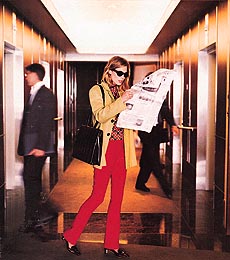Corporate couture
Fashion
By Sumona Roy
CORPORATE couture is going through
a design overhaul in both its variations: as office
uniform and in what is understood as power dressing.
Predictably, the changes are visible more in women’s
wear than in men’s.
 Most
Indian designers are going by yardsticks fixed by the
west, even in the classification: one, what one
voluntarily wears to work, and two, designing exclusive
institutional wear. Most
Indian designers are going by yardsticks fixed by the
west, even in the classification: one, what one
voluntarily wears to work, and two, designing exclusive
institutional wear.
Moreover, for the first
time, they are entering into contracts with companies
that amount to patenting designs. In other words, the
same designs, colour schemes and patterns cannot be used
for any other business house.
For instance, the Taj
group of the hotels has engaged Ravi Bajaj to design the
uniform of its front -office staff in keeping with the
"business-like image they want to portray".
Earlier, the general manager’s wife decided what the
staff should wear.
"The response to
institutional designer wear has been very positive,"
says the Delhi-based designer, who has earlier worked
with an airline company and the Hyatt Regency hotel.
"Companies are beginning to realise that what
employees wear reflects the corporate image."
However, Rina Dhaka,
another Delhi-based designer, feels that working people
still prefer a range that is stylish, easy to wash and
maintain. "This explains why the salwar-kameez
and kurta-pyjama have remained the corporate dress
mantra," she observes.
An upcoming designer,
Jay Ramrakhiani, believes that there is a lot of scope
for innovations in corporate wear, starting with jacket,
shirt and scarf for women. "The shirt can be
alternated with a ruffled blouse or camisole," he
suggests.
Bajaj feels that the
classic skirt-white blouse combination, embossed with the
wearer’s name or the corporate logo, takes on a more
contemporay look and feel. Tunic-style shirts,which are
deliciously cool and trendy, also make an impact.
Other designers
specialising in corporate wear include names like Krishna
Mehta, Priyadarshini Rao and Azeem Khan. However, for
them, it is always better to improvise on conventional
formal wear, rather than create uniforms that may not
always suit every wearer.
Effectively, this would
mean salwar-kameez would soon make way for
pinstripes, jackets, trousers and skirts. Somehow, sarees
do not fit into the scheme of things, even though the
hospitality industry and the airlines were the first to
adopt them to project an Indian image.
One area of concern
however, still remains: how to beat the Indian summer?
Designers constantly face complaints of uniforms leading
to excessive perspiration, even in air-conditioned
working environments.
Clearly, the solution to
this is taking up light-weight airy fabrics like cotton
and jersey. But then, these are not always easy to
maintain and less durable than synthetics. Besides, a
separate set of uniforms requires to be designed for the
winter.
Preferences of corporate
houses, however, centre around cotton-rayon,
viscose-rayon, polyester-cotton and viscose blends. Silks
andchamois satin are usually meant for senior,
supervisory staff. The bottomline, of course, is that
clothes have to durable, wrinkle-free and easy to
maintain.
Style-wise, too, there
are very clear do’s and don’ts for designing
corporate wear. For women, the cut fall and styling of
fabric assume prime importance. Prints are never combined
with prints, but with neutrals, black, navy-blue, white
or beige.
Skirts are generally
maintained at knee level and to be on the safer side,
tucked-in shirts are not recommended. Over accessorising
with make-up and jewellery are also discouraged.
For men, tailored suits
are sartorially savvy provided the fitting is prefect.
This involves, among other things that one-fourth of an
inch of the shirt sleeve shows below the jacket and that
its collar is half-an-inch to three-fourths of an inch
lower than the shirt collar.
Trouser lengths need to
be double-checked with the wearer and accessorised with
matching shoes. Leather belts are usually one-inch thick.
White cotton socks,cross-over sandals and sneakers are a
complete no-no for corporate wear.
After all, nothing can
damage the image of a company more than the impression
created by a set of badly-dressed employees. (MF)
|

![]()

